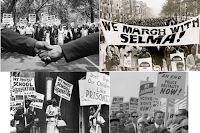Our June 22, 2020, post explored whether the uprising we’ve seen since the May 25 murder of 46-year-old George Floyd by a Minneapolis police officer differs from previous civil rights
protests. We examined competing police reform measures and considered political calculations that may affect proposed legislation.
Now we explore broader questions about the same topic. Are we witnessing civil unrest that
subsides once emotions die down or real revolution that leads to systemic societal changes? People ask because many aspects of this look different, certainly than the 1960s civil rights protests the three of us witnessed in our formative years. We start with some basics.
Multi-ethnic sacrifice
The civil rights struggle in America has always been diverse and multi-ethnic.
Consider the lost lives of Viola Liuzzo, Reverend James Reeb, Andrew Goodman, and Michael Schwerner, four white people killed while doing civil rights work in the South. Viola Liuzzo, a Detroit housewife, went to Alabama in 1965 to help with Martin Luther King’s voter registration campaign. As she drove marchers between Selma and Montgomery on March 25, four Ku Klux
Klansmen shot and killed her. Southern resisters attacked and killed Reeb, a Unitarian minister from Boston, in Selma two weeks earlier. A Klan-led mob murdered Goodman and Schwerner, along with black Mississippian James Cheney, in Neshoba County, Mississippi as they tried registering black voters during the Freedom Summer of 1964.
Klansmen shot and killed her. Southern resisters attacked and killed Reeb, a Unitarian minister from Boston, in Selma two weeks earlier. A Klan-led mob murdered Goodman and Schwerner, along with black Mississippian James Cheney, in Neshoba County, Mississippi as they tried registering black voters during the Freedom Summer of 1964.
White people who didn’t make the sacrifice
Luizzo, Reeb, Schwerner, and Goodman made still contributed mightily to the civil rights cause in the 1960s. This isn’t the first time the races have joined forces in the struggle for equality.
A different feel
All that said, some things seem different this time. White participation in the protests following Floyd’s death just looks bigger. In
foreign countries, organic protests erupted in the streets. At a qualitative level, hope has surfaced that whites participating in this round of protests “get it.” White marchers seem invested in the grievances African Americans have with police brutality and systemic racism. White people are talking both with blacks and among each other about racial problems and seem fueled by a sense of responsibility.
Another big difference lies in the availability of social media. Platforms like Twitter,
Facebook, and Instagram mean the voiceless aren’t voiceless anymore. People have more opportunities for expressing themselves. They need worry less about accessing broadcast and print outlets controlled by others. People can speak out knowing many will hear.
Positive involvement of the corporate sector distinguishes what’s happening now from previous protest cycles. Large companies acknowledge they must respond to how their customers view racial justice issues. After consumer pressure, for example, Starbucks changed its policy so employees could wear “Black Lives Matter” shirts.
Finally, people hungry for information about racial matters can access more credible writing on the subject now than in the ’60s. More scholars, some black and some white, research and write about racial issues. Popular writers contribute to this growing, robust race discrimination literature. We suggested popular and scholarly works in a recent post concerning the education of white America about race.
Challenges
If this is different, what obstacles could derail the movement and destroy the moment? Revolutions
often have generals – commanders who lead foot soldiers, develop strategy, and direct operations. The 1960s civil rights movement certainly had a supreme commander in Martin Luther King, Jr. A capable staff
assisted him, led by notables like his Southern Christian Leadership Conference deputy Ralph Abernathy, NAACP Executive Director Roy Wilkins, union stalwart A. Phillip Randolph, and Urban League leader Whitney Young. Ascending figures like Fannie Lou Hamer, John Lewis, and Andrew Young made significant contributions. Such a leadership team isn’t around today.
An argument also exists that protest movements don’t need a general on the order of a Martin Luther King. Eric Hoffer suggested in The True
Believer that mass movements require three elements: (1) readying the ground by those “whose chief claim to excellence is their skill in the use of the spoken or written word,” (2) the temperament and talents of fanatics, and (3) “final consolidation” by practical people of action.
We see elements of such an array forming. Writers like legal scholar Michelle Alexander, author of The New Jim Crow, essayist Ta-Nehisi Coates, and
sociologist Robin Diangelo, who wrote the best-selling White Fragility: Why it’s so Hard for White People to Talk about Racism might serve as Hoffer’s women and “men of words.” Identifying fanatics isn’t easy, but they’re showing themselves. Take, for example, the young people who’ve spearheaded the nationwide Justice for Breonna movement protesting the March shooting death of 26-year-old medical technician Breonna Taylor by police in her home in Louisville, Kentucky during execution of a no-
knock drug case warrant. As for practical people of action, we nominate William Barber, the North Carolina cleric who sometimes functions as the conscience of the nation on equality and fairness issues. Then there’s House Speaker Nancy Pelosi, trying to steer substantive police reform legislation
through Congress. Perhaps she can get help next year from a President Joe Biden and a Senate Majority Leader Chuck Schumer.
through Congress. Perhaps she can get help next year from a President Joe Biden and a Senate Majority Leader Chuck Schumer.
We point out Henry does not accept Hoffer’s concept of “fanatics,” but recognizes the importance in social movements of those with “firm commitment and zeal.”
We must end with a note of caution. The opposition has its general – the current occupant of the White House – and its chief of staff, Senate Republican leader Mitch McConnell. We need say no more.



























